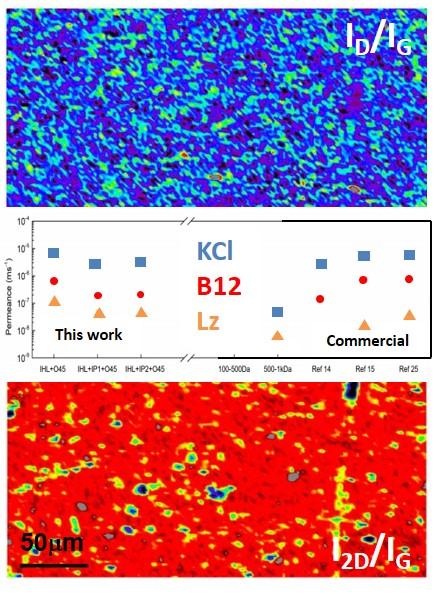
Ratio of intensities of Raman D and G bands (ID/IG) is used as a measure of damage in graphene membranes; brighter colors indicate higher degree of oxidative damage for commercial graphene - ID/IG (top) and nanoporous graphene - I2D/IG (bottom). Diffusive permeance (center) of fabricated nanoporous membrane compared with commercial, state-of-the-art dialysis membranes.
Scientific Achievement
We report a novel roll-to-roll, isopropanol-assisted hot lamination process for the scalable manufacturing of high-quality, functional, atomically thin nanoporous graphene membranes.
Significance and Impact
Demonstrated ∼2–3 orders of magnitude higher permeance and improved selectivity compared with commercial, state-of-the-art polymeric dialysis membranes.
Research Details
– Water-assisted oxidation was used to decouple CVD graphene from Cu substrate to facilitate transfer and oxidize graphene wrinkles forming a distribution of tear/pore sizes: 19.2% (>50nm); ∼26% (1–50nm); ∼20% (0.66–1nm) – Pressure-driven (with ethanol) and diffusion-driven flows with KCl (∼0.66nm), Vitamin B12 (∼1–1.5nm), and Lysozyme (∼3.8–4nm) were used to characterize the pore size distributions.P. Cheng, N. K. Moehring, J. C. Idrobo, I. N. Ivanov, and P. R. Kidambi, "Scalable Synthesis of Nanoporous Atomically Thin Graphene Membranes of Dialysis and Molecular Separations via Facile Isopropanol-Assisted Hot Lamination," Nanoscale 13, 2825 (2021). DOI:10.1039/d0nr07384a


